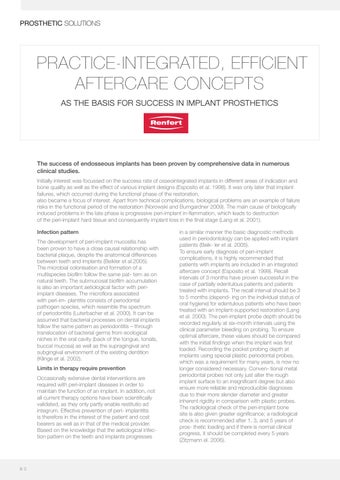PROSTHETIC SOLUTIONS
PRACTICE-INTEGRATED, EFFICIENT AFTERCARE CONCEPTS AS THE BASIS FOR SUCCESS IN IMPLANT PROSTHETICS
The success of endosseous implants has been proven by comprehensive data in numerous clinical studies. Initially interest was focussed on the success rate of osseointegrated implants in different areas of indication and bone quality as well as the effect of various implant designs (Esposito et al. 1998). It was only later that implant failures, which occurred during the functional phase of the restoration, also became a focus of interest. Apart from technical complications, biological problems are an example of failure risks in the functional period of the restoration (Norowski and Bumgardner 2009). The main cause of biologically induced problems in the late phase is progressive peri-implant in-flammation, which leads to destruction of the peri-implant hard tissue and consequently implant loss in the final stage (Lang et al. 2001). Infection pattern The development of peri-implant mucositis has been proven to have a close causal relationship with bacterial plaque, despite the anatomical differences between teeth and implants (Beikler et al.2005). The microbial colonisation and formation of a multispecies biofilm follow the same pat- tern as on natural teeth. The submucosal biofilm accumulation is also an important aetiological factor with periimplant diseases. The microflora associated with peri-im- plantitis consists of periodontal pathogen species, which resemble the spectrum of periodontitis (Luterbacher et al. 2000). It can be assumed that bacterial processes on dental implants follow the same pattern as periodontitis – through translocation of bacterial germs from ecological niches in the oral cavity (back of the tongue, tonsils, buccal mucosa) as well as the supragingival and subgingival environment of the existing dentition (Klinge et al. 2002). Limits in therapy require prevention Occasionally extensive dental interventions are required with peri-implant diseases in order to maintain the function of an implant. In addition, not all current therapy options have been scientifically validated, as they only partly enable restitutio ad integrum. Effective prevention of peri- implantitis is therefore in the interest of the patient and cost bearers as well as in that of the medical provider. Based on the knowledge that the aetiological infection pattern on the teeth and implants progresses
8 2
in a similar manner the basic diagnostic methods used in periodontology can be applied with implant patients (Beik- ler et al. 2005). To ensure early diagnosis of peri-implant complications, it is highly recommended that patients with implants are included in an integrated aftercare concept (Esposito et al. 1999). Recall intervals of 3 months have proven successful in the case of partially edentulous patients and patients treated with implants. The recall interval should be 3 to 5 months (depend- ing on the individual status of oral hygiene) for edentulous patients who have been treated with an implant-supported restoration (Lang et al. 2000). The peri-implant probe depth should be recorded regularly at six-month intervals using the clinical parameter bleeding on probing. To ensure optimal aftercare, these values should be compared with the initial findings when the implant was first loaded. Recording the pocket probing depth at implants using special plastic periodontal probes, which was a requirement for many years, is now no longer considered necessary. Conven- tional metal periodontal probes not only just alter the rough implant surface to an insignificant degree but also ensure more reliable and reproducible diagnoses due to their more slender diameter and greater inherent rigidity in comparison with plastic probes. The radiological check of the peri-implant bone site is also given greater significance; a radiological check is recommended after 1, 3, and 5 years of pros- thetic loading and if there is normal clinical progress, it should be completed every 5 years (Zitzmann el. 2006).











